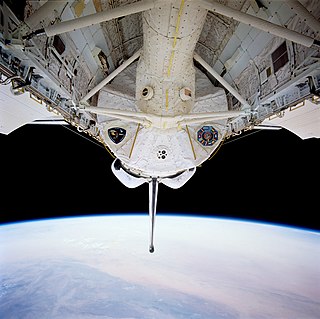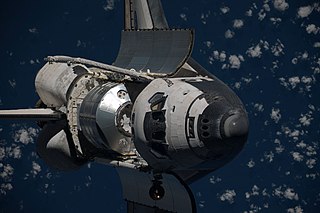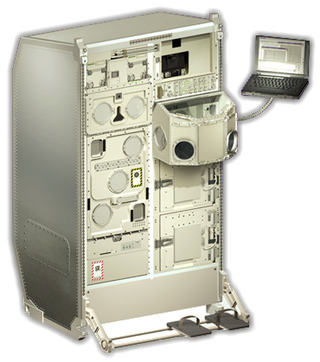
The International Space Station (ISS) is the largest modular space station in low Earth orbit. The project involves five space agencies: the United States' NASA, Russia's Roscosmos, Japan's JAXA, Europe's ESA, and Canada's CSA. The ownership and use of the space station is established by intergovernmental treaties and agreements. The station serves as a microgravity and space environment research laboratory in which scientific research is conducted in astrobiology, astronomy, meteorology, physics, and other fields. The ISS is suited for testing the spacecraft systems and equipment required for possible future long-duration missions to the Moon and Mars.

STS-65 was a Space Shuttle program mission of Columbia launched from Kennedy Space Center, Florida, 8 July 1994. The flight carried a crew of 7 and was commanded by Robert D. Cabana who would go on later to lead the Kennedy Space Center. STS-65 was an international science mission that carried the International Microgravity Laboratory (IML-2) on an 15-day mission. Columbia returned to the Kennedy Space Center on 23 July 1994.

STS-78 was the fifth dedicated Life and Microgravity Spacelab mission for the Space Shuttle program, flown partly in preparation for the International Space Station project. The mission used the Space Shuttle Columbia, which lifted off successfully from Kennedy Space Center's Launch Pad 39B on June 20, 1996. This marked the 78th flight of the Space Shuttle and 20th mission for Columbia.

STS-79 was the 17th flight of Space Shuttle Atlantis, and the 79th mission of the Space Shuttle program. The flight saw Atlantis dock with the Russian space station Mir to deliver equipment, supplies and relief personnel. A variety of scientific experiments were also conducted aboard Atlantis by her crew. It was the first shuttle mission to rendezvous with a fully assembled Mir, and the fourth rendezvous of a shuttle to the space station.

STS-81 was a January 1997 Space Shuttle Atlantis mission to the Mir space station.

The Destiny module, also known as the U.S. Lab, is the primary operating facility for U.S. research payloads aboard the International Space Station (ISS). It was berthed to the Unity module and activated over a period of five days in February, 2001. Destiny is NASA's first permanent operating orbital research station since Skylab was vacated in February 1974.

Expedition 1 was the first long-duration stay on the International Space Station (ISS). The three-person crew stayed aboard the station for 136 days, from November 2000 to March 2001. It was the beginning of an uninterrupted human presence on the station which continues as of 2023. Expedition 2, which also had three crew members, immediately followed Expedition 1.

Tranquility, also known as Node 3, is a module of the International Space Station (ISS). It contains environmental control systems, life support systems, a toilet, exercise equipment, and an observation cupola.

The Shuttle–Mir program was a collaborative 11-mission space program between Russia and the United States that involved American Space Shuttles visiting the Russian space station Mir, Russian cosmonauts flying on the Shuttle, and an American astronaut flying aboard a Soyuz spacecraft to engage in long-duration expeditions aboard Mir.

The Fluid Science Laboratory is a European (ESA's) science payload designed for use in Columbus built by Alenia Spazio, OHB-System and Verhaert Design and Development. It is a multi-user facility for conducting fluid physics research in microgravity conditions. It can be operated in fully or in semi-automatic mode and can be controlled on board by the ISS astronauts, or from the ground in the so-called telescience mode.

The effects of spaceflight on the human body are complex and largely harmful over both short and long term. Significant adverse effects of long-term weightlessness include muscle atrophy and deterioration of the skeleton. Other significant effects include a slowing of cardiovascular system functions, decreased production of red blood cells, balance disorders, eyesight disorders and changes in the immune system. Additional symptoms include fluid redistribution, loss of body mass, nasal congestion, sleep disturbance, and excess flatulence. Overall, NASA refers to the various deleterious effects of spaceflight on the human body by the acronym RIDGE.

A space toilet or zero-gravity toilet is a toilet that can be used in a weightless environment. In the absence of weight, the collection and retention of liquid and solid waste is directed by use of airflow. Since the air used to direct the waste is returned to the cabin, it is filtered beforehand to control odor and cleanse bacteria. In older systems, wastewater is vented into space, and any solids are compressed and stored for removal upon landing. More modern systems expose solid waste to vacuum pressures to kill bacteria, which prevents odor problems and kills pathogens.

STS-128 was a NASA Space Shuttle mission to the International Space Station (ISS) that launched on August 28, 2009. Space ShuttleDiscovery carried the Multi-Purpose Logistics Module Leonardo as its primary payload. Leonardo contained a collection of experiments for studying the physics and chemistry of microgravity. Three spacewalks were carried out during the mission, which removed and replaced a materials processing experiment outside ESA's Columbus module, and returned an empty ammonia tank assembly.

Biolab is a single-rack multi-user science payload designed for use in the Columbus laboratory of the International Space Station. Biolab support biological research on small plants, small invertebrates, microorganisms, animal cells, and tissue cultures. It includes an incubator equipped with centrifuges in which the preceding experimental subjects can be subjected to controlled levels of accelerations.

Weightlessness is the complete or near-complete absence of the sensation of weight, i.e., zero apparent weight. It is also termed zero gravity, zero g-force, or zero-g. Micro-g environment is more or less synonymous, with the recognition that g-forces are never exactly zero.

The International Space Station Environmental Control and Life Support System (ECLSS) is a life support system that provides or controls atmospheric pressure, fire detection and suppression, oxygen levels, waste management and water supply. The highest priority for the ECLSS is the ISS atmosphere, but the system also collects, processes, and stores both waste and water produced and used by the crew—a process that recycles fluid from the sink, shower, toilet, and condensation from the air.

The International Space Station is a platform for scientific research that requires one or more of the unusual conditions present in low Earth orbit. The primary fields of research include human research, space medicine, life sciences, physical sciences, astronomy and meteorology. The 2005 NASA Authorization Act designated the American segment of the International Space Station as a national laboratory with the goal of increasing the use of the ISS by other federal agencies and the private sector.
ELIPS - European Programme for Life and Physical Sciences in Space and applications utilising the International Space Station started in 2001 and was intended to cover the activities for the following 5 years. This Microgravity Programme at the European Space Agency (ESA) is an optional programme, with currently 17 ESA member states participating. The ELIPS programme prepares and performs research on the International Space Station, and other uncrewed mission platforms like Sounding Rockets, in fundamental and applied life and physical sciences. ELIPS is the continuation of the earlier European microgravity programmes EMIR 1&2, and the Microgravity Facilities for Columbus, MFC.

Astronaut training describes the complex process of preparing astronauts in regions around the world for their space missions before, during and after the flight, which includes medical tests, physical training, extra-vehicular activity (EVA) training, procedure training, rehabilitation process, as well as training on experiments they will accomplish during their stay in space.

Locomotion in space includes all actions or methods used to move one's body in microgravity conditions through the outer space environment. Locomotion in these conditions is different from locomotion in a gravitational field. There are many factors that contribute to these differences, and they are crucial when researching long-term survival of humans in space.























